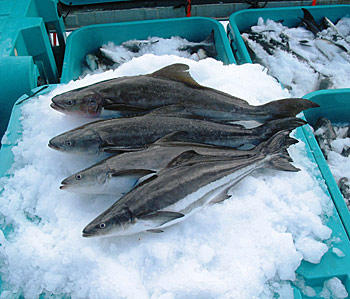
Cobia (Rachycentron canadum) harvested from a fish farm.
When it comes to the food used to raise fish in aquaculture "farms," it seems that you may get what you pay for. In a new study,* researchers from the National Institute of Standards and Technology (NIST) and the South Carolina Department of Natural Resources (SCDNR) looked at the health effects of raising farmed fish on a diet incorporating less than the usual amount of fishmeal—a key but expensive component of current commercial fish food products. They learned that reduced fishmeal diets may be cheaper, but the fish were less healthy.
Commercial aquaculture is one of the fastest growing areas of food production, produces about $100 billion of revenue annually and accounts for nearly half of the world's food fish supply. Aquafarmers currently rely heavily on fishmeal as a protein source but it's expensive to produce and the resource from which it's derived—fish captured in the wild—is being rapidly depleted. One proposed remedy is to substitute cheaper and more environmentally friendly foods that replace some fishmeal content with other sources of protein.
SCDNR designed a study to evaluate the efficacy of diets with reduced and full amounts of fishmeal fed to cobia**, a popular marine aquaculture fish, during the period when juveniles mature to adults. One diet contained 50 percent and another 75 percent less fishmeal than that found in commercial food products. A third diet contained 100 percent of the conventional fishmeal content. A fourth group of cobia ate off-the-shelf fish food as a control.
To determine whether or not the three experimental diets provided adequate nutrition for fish growth, the SCDNR teamed with NIST's nuclear magnetic resonance (NMR) spectroscopy experts at the Hollings Marine Laboratory (HML) in Charleston, S.C. NMR spectroscopy, a technique similar to magnetic resonance imaging (MRI) used by doctors, allows researchers to isolate and identify specific nutrients after the fish have metabolized them—a quantifiable measure of how well or how poorly the different fishmeal diets were utilized.
The results showed that cobia fed the reduced fishmeal diets were metabolically different from those fed either the full fishmeal diet or the control diet. Fish fed the reduced fishmeal diets had higher levels of two metabolites linked to physical stress, tyrosine and betaine, and lower levels of a primary energy source, glucose. This suggests that these cobia were not receiving the necessary nutrition to support healthy growth.
Overall, the researchers were surprised to find that cobia on the experimental 100 percent fishmeal diet showed the most growth by the end of the 100-day study period. Along with more normal tyrosine, betaine and glucose levels, NMR spectroscopy also revealed significantly higher levels of lactate in cobia fed 100 percent fishmeal compared to fish on the other diets. This finding may be explained by the fact that the 100 percent fishmeal experimental diet has the highest percentage of the carbohydrate cornstarch, and lactate is produced by gut bacteria metabolizing carbohydrates. In turn, since efficient breakdown of carbohydrates is essential to energy production, the researchers surmise that a diet enhancing gut microflora activity might be one of the conditions needed for optimal cobia health.
Although the reduced fishmeal diets in this study did not fare well, the NIST and SCDNR researchers say that the data from the NMR-based metabolomic analysis still provide insight into what might be needed for more successful formulations. They expect that future studies will eventually lead to alternative dietary products that are more cost effective, better for the environment and lead to high yields of healthy fish.
The HML is a unique partnership of governmental and academic agencies including NIST, the National Oceanic and Atmospheric Administration's National Ocean Service, the SCDNR, the College of Charleston and the Medical University of South Carolina. The HML NMR facility focuses on the multi-institutional mission of metabolomics, natural products and structural biology.
* T.B. Schock, S. Newton, K. Brenkert, J. Leffler and D.W. Bearden. An NMR-based metabolomic assessment of cultured cobia health in response to dietary manipulation. Food Chemistry, Vol. 133, No. 1, pages 90-101, July 1, 2012.
** Rachycentron canadum.

